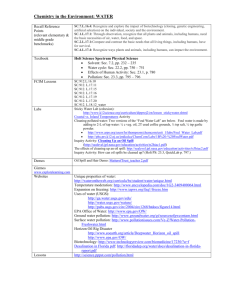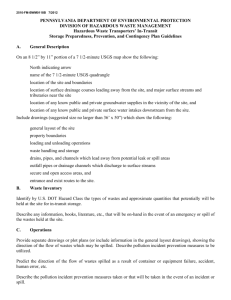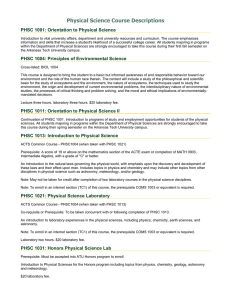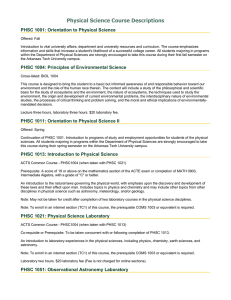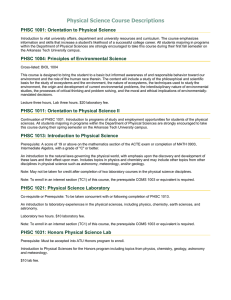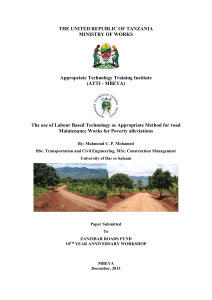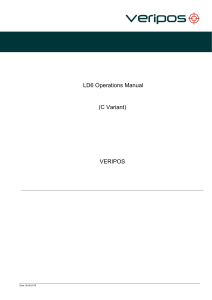PHSC_CGT_ResourPagUnit10_V02
advertisement
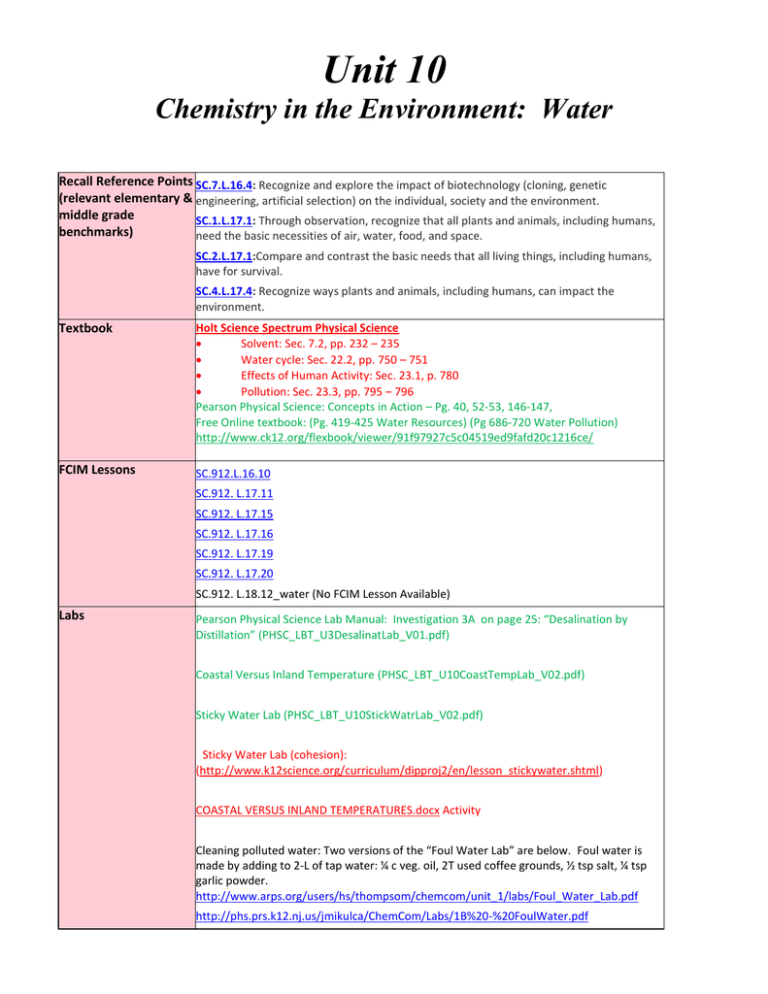
Unit 10 Chemistry in the Environment: Water Recall Reference Points SC.7.L.16.4: Recognize and explore the impact of biotechnology (cloning, genetic (relevant elementary & engineering, artificial selection) on the individual, society and the environment. middle grade SC.1.L.17.1: Through observation, recognize that all plants and animals, including humans, benchmarks) need the basic necessities of air, water, food, and space. SC.2.L.17.1:Compare and contrast the basic needs that all living things, including humans, have for survival. SC.4.L.17.4: Recognize ways plants and animals, including humans, can impact the environment. Textbook Holt Science Spectrum Physical Science Solvent: Sec. 7.2, pp. 232 – 235 Water cycle: Sec. 22.2, pp. 750 – 751 Effects of Human Activity: Sec. 23.1, p. 780 Pollution: Sec. 23.3, pp. 795 – 796 Pearson Physical Science: Concepts in Action – Pg. 40, 52-53, 146-147, Free Online textbook: (Pg. 419-425 Water Resources) (Pg 686-720 Water Pollution) http://www.ck12.org/flexbook/viewer/91f97927c5c04519ed9fafd20c1216ce/ FCIM Lessons SC.912.L.16.10 SC.912. L.17.11 SC.912. L.17.15 SC.912. L.17.16 SC.912. L.17.19 SC.912. L.17.20 SC.912. L.18.12_water (No FCIM Lesson Available) Labs Pearson Physical Science Lab Manual: Investigation 3A on page 25: “Desalination by Distillation” (PHSC_LBT_U3DesalinatLab_V01.pdf) Coastal Versus Inland Temperature (PHSC_LBT_U10CoastTempLab_V02.pdf) Sticky Water Lab (PHSC_LBT_U10StickWatrLab_V02.pdf) Sticky Water Lab (cohesion): (http://www.k12science.org/curriculum/dipproj2/en/lesson_stickywater.shtml) COASTAL VERSUS INLAND TEMPERATURES.docx Activity Cleaning polluted water: Two versions of the “Foul Water Lab” are below. Foul water is made by adding to 2-L of tap water: ¼ c veg. oil, 2T used coffee grounds, ½ tsp salt, ¼ tsp garlic powder. http://www.arps.org/users/hs/thompsom/chemcom/unit_1/labs/Foul_Water_Lab.pdf http://phs.prs.k12.nj.us/jmikulca/ChemCom/Labs/1B%20-%20FoulWater.pdf Inquiry Activity: CLEANING UP AN OIL SPILL.docx (http://sealevel.jpl.nasa.gov/education/activities/ts2hiac1.pdf) The effects of cleaning up an oil spill: http://sealevel.jpl.nasa.gov/education/activities/ts3hiac2.pdf Inquiry Activity: How can oil spills be cleaned up? (Holt PS: 23.3, QuickLab p. 797.) Demos Oil Spill and Hair Demo (PHSC_LBT_U10OilHairDemo_V02.pdf) Oil Spill and Hair Demo: MatterofTrust_teacher 2.pdf Link or File not found Gizmos explorelearning.com Water Cycle: http://www.explorelearning.com/index.cfm?method=cResource.dspView&ResourceID=435 Water Pollution: http://www.explorelearning.com/index.cfm?method=cResource.dspView&ResourceID=445 Websites Water Footprint Calculator: http://environment.nationalgeographic.com/environment/freshwater/water-footprintcalculator/ Unique properties of water: http://waterontheweb.org/curricula/bs/student/water/unique.html Temperature moderation: http://www.encyclopedia.com/doc/1G2-3409400064.html Expansion on freezing: http://www.iapws.org/faq1/freeze.htm Uses of water (USGS): http://ga.water.usgs.gov/edu/ http://water.usgs.gov/watuse/ http://pubs.usgs.gov/circ/2004/circ1268/htdocs/figure14.html EPA Office of Water: http://www.epa.gov/OW/ Ground water pollution: http://www.groundwater.org/gi/sourcesofgwcontam.html Surface water pollution: http://www.pollutionissues.com/Ve-Z/Water-PollutionFreshwater.html Horizon Oil Rig Disaster http://www.eoearth.org/article/Deepwater_Horizon_oil_spill http://www.epa.gov/OW/ Biotechnology: http://www.technologyreview.com/biomedicine/17230/?a=f http://floridadep.org/water/docs/desalination-in-florida-report.pdf desalination-in-florida-report.pdf Lessons http://science.pppst.com/watercycle.html http://science.pppst.com/pollution.html * Please send activities as attachments
